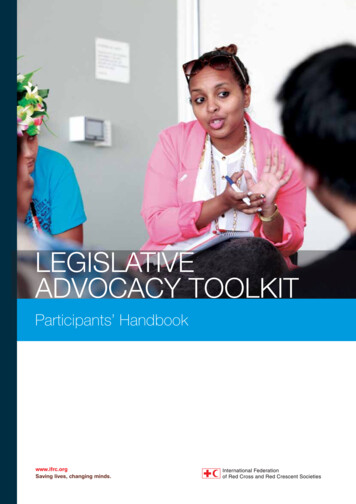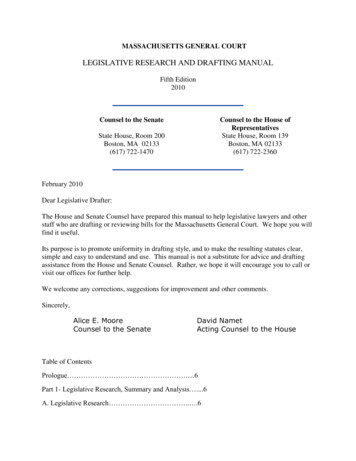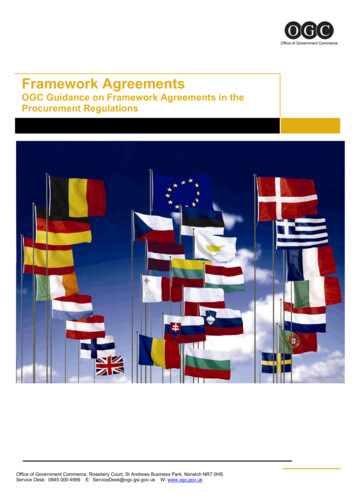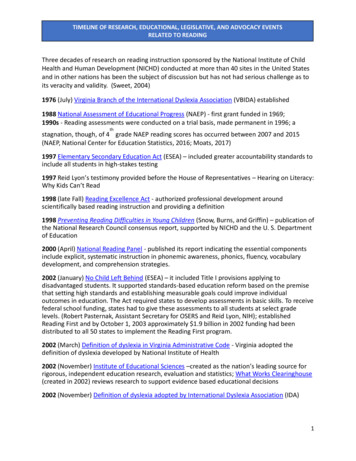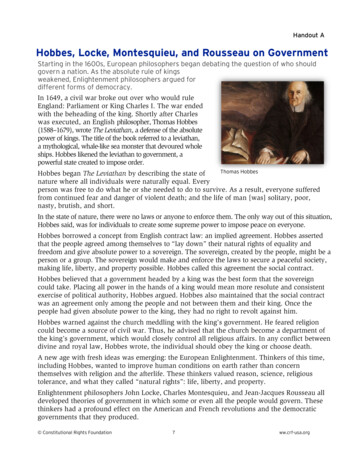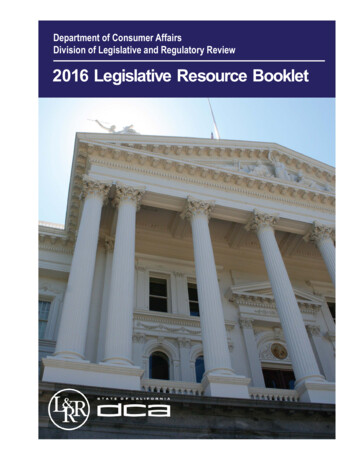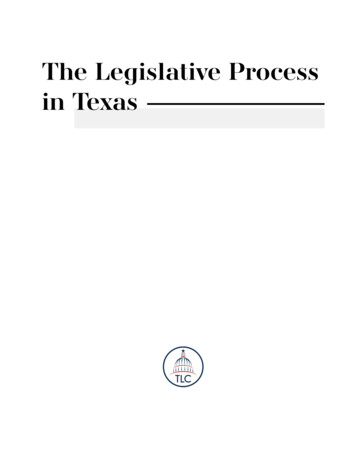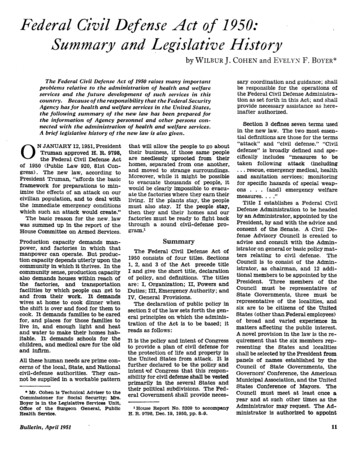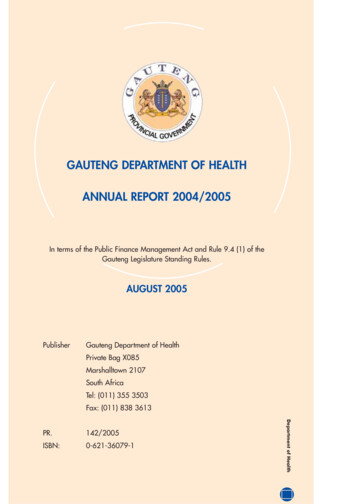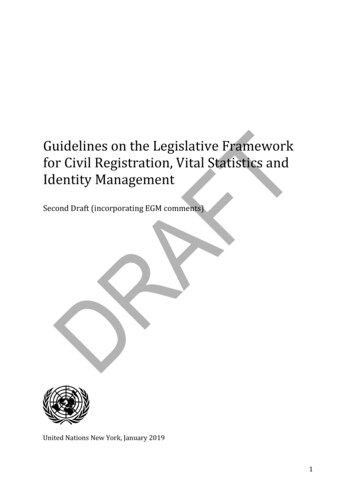
Transcription
Guidelines on the Legislative Frameworkfor Civil Registration, Vital Statistics andIdentity ManagementSecond Draft (incorporating EGM comments)United Nations New York, January 20191
This draft is prepared by United Nations Statistics Division and Vital Strategies withfinancial support from the Bloomberg Data for Health Initiative.United NationsStatistics Division2
AcknowledgementsThe present publication was prepared by the United Nations Statistics DivisionStefan Schweinfest, DirectorThe contributions of the following are gratefully acknowledged.EditorsSrdjan Mrkic, lead editorMary-Lynn SferrazzaDraftersMary-Lynn Sferrazza, Vital StrategiesAshley Frederes, Vital StrategiesAaron Schwid, Vital StrategiesContributorsMaria Isabel Cobos, United Nations Statistics DivisionAndrew Smith, United Nations Statistics DivisionLin Zhuo, United Nations Statistics DivisionReviewers – members of the Expert GroupKathrina Lo, AustraliaA K M Ashraful Haque, BangladeshMaria de Fatima Marinho de Souza, BrazilSonia Herrera, EcuadorStephen Amoah, GhanaNouf Alkhaleefi, KuwaitVictor Mallewa, MalawiJeff Montgomery, New ZealandTrude Åsrum, NorwayKåre Vassenden , NorwayCharity Tan, PhilippinesIngegerd Widell, SwedenMyer Glickman, United Kingdom of Great Britain and Northern IrelandOlga Joos, United States of AmericaEmily Cercone, United States of AmericaMartin Nyahoda, ZambiaXuan Che, United Nations Statistics DivisionNiall McCann, United Nations Development ProgrammeKristen Wenz, United Nations Children's FundWendy MacClinchy, United Nations High Commissioner for RefugeesRomesh Silva, United Nations Population FundDavid Satola, World BankJonathan Marskell, World BankRebeca Omaña Penaloza, Organization of American StatesPhilip Setal, Vital StrategiesDesign, typesetting and proofreadingCover:Graphic Design Unit, Department of Public InformationInterior:English Copy Preparation and Proofreading Unit, Department for General Assembly and ConferenceManagement3
ContentsI.Introduction. 7II. Overview of Civil Registration, Vital Statistics and Identity ManagementSystems . 10A.INTRODUCTION . 10B.CONCEPTS AND DEFINITIONS . 10D.FUNCTIONS OF CIVIL REGISTRATION AND NATIONAL IDENTITY MANAGEMENT . 25C.PRINCIPLES OF CIVIL REGISTRATION AND NATIONAL IDENTITY MANAGEMENT . 13E.VITAL EVENTS .29G.INTEROPERABILITY .36F.H.IDENTITY MANAGEMENT AND IDENTITY LIFECYCLE . 31ACCOUNTABILITY AND GOVERNANCE . 39III. Human Rights and Civil Registration, Vital Statistics and Identity ManagementSystems . 42A.RIGHTS-BASED APPROACH TO CRVSID LEGAL FRAMEWORKS . 42B.RIGHT TO REGISTER VITAL EVENTS .44D.PROTECTION OF VULNERABLE POPULATIONS . 54A.CENTRALIZED VERSUS DECENTRALIZED SYSTEMS. 59C.HUMAN RIGHTS THAT MAY DEPEND ON THE REGISTRATION OF VITAL EVENTS .46IV. Institutional Arrangements for Civil Registration, Vital Statistics and IdentityManagement Systems . 59B.SINGLE VERSUS MULTIPLE LEAD AGENCIES . 60D.POWER TO ISSUE REGULATIONS AND TO DELEGATE AUTHORITY . 63F.THE ROLE OF THE POLICE, MEDICAL-LEGAL OFFICERS AND EMERGENCY SERVICES.68C.E.MINISTRY VERSUS AUTONOMOUS AGENCY .62THE ROLE OF THE HEALTH SECTOR . 65G.THE ROLE OF CUSTODIANS OF FUNERAL, BURIAL AND CREMATION FACILITIES .69I.INTER-AGENCY COOPERATION . 71H.J.THE ROLE OF THE COURTS .69FINANCIAL RESOURCES . 72V. Legislative Framework. 74SECTION 1. GENERAL PROVISIONS AND ADMINISTRATIVE INFRASTRUCTURE .764
A.GENERAL PROVISIONS . 76B.CIVIL REGISTRATION, VITAL STATISTICS, AND IDENTITY MANAGEMENT INFRASTRUCTURE . 79A.REGISTRATION OF BIRTH.86SECTION 2. CIVIL REGISTRATION .86B.REPORTING OF FOETAL DEATH . 101D.REGISTRATION OF MARRIAGE. 120C.E.F.G.REGISTRATION OF DEATH . 103REGISTRATION OF DISSOLUTION OF MARRIAGE OR CIVIL UNION . 125CORRECTIONS AND AMENDMENTS TO THE RECORD . 126SUBMISSION OF LOCAL REGISTRAR RECORDS TO NATIONAL REGISTRAR . 129H.FEES .131A.IDENTITY MANAGEMENT PRINCIPLES AND LIFE CYCLE . 133SECTION 3. IDENTITYMANAGEMENT .132B.FEES . 142A.INFORMATION TO BE SUBMITTED TO THE POPULATION REGISTER . 144SECTION 4. THE POPULATION REGISTER .143B.SUBMISSION PROCEDURES . 146D.DATA PROTECTION AND PRIVACY DURING TRANSMISSION TO AND STORAGE IN THE POPULATIONC.SUBMISSION FREQUENCY . 146REGISTER . 147E.POPULATION REGISTER SUMMARY . 147A.VITAL STATISTICS TO BE DERIVED FROM CIVIL REGISTRATION DATA . 147SECTION 5. VITAL STATISTICS .147B.SUBMISSION OF STATISTICAL INFORMATION TO STATISTICS AUTHORITY . 149D.PUBLICATION AND DISSEMINATION OF VITAL STATISTICS REPORTS . 151C.COMPILATION OF VITAL STATISTICS . 149E.VITAL STATISTICS SUMMARY . 151A.THE UN PERSONAL DATA AND PRIVACY PRINCIPLES . 152SECTION 6. DATA PROTECTION, PRIVACY AND SECURITY .152B.DATA PROTECTION, PRIVACY AND SECURITY SUMMARY . 159A.MONITORING AND INSPECTION . 160SECTION 7. COMPLIANCE, ENFORCEMENT, RIGHTS AND REMEDIES .159I.ADMINISTRATIVE AND JUDICIAL REVIEW .1615
C.OFFENSES AND PENALTIES .161E.COMPLIANCE, ENFORCEMENT, RIGHTS AND REMEDIES SUMMARY . 162D.REVENUE TO FUND THE SYSTEM . 162SECTION 8. TRANSITIONAL PROVISIONS .163VI. OTHER LAWS AND POLICIES THAT SUPPORT CRVSID SYSTEMS: INCENTIVES,MEDICAL PROFESSION TRAINING, AND TECHNOLOGY . 165A.INCENTIVES FOR INSTITUTIONAL COMPLIANCE . 165B.CREATING INDIVIDUAL DEMAND FOR IDENTITY CREDENTIALS . 166D.IMPROVING CAUSE OF DEATH INFORMATION . 171C.E.CREATING INDIVIDUAL DEMAND FOR CIVIL REGISTRATION . 167FACILITATING USE OF TECHNOLOGY . 172Annex A - Recommended Information for birth, death and foetal deathregistration . 173Annex B - Recommended Information for marriage and divorceregistration . 1766
I.Introduction1. The United Nations Statistics Division (UNSD) has been mandated with the development ofthe methodological framework for civil registration and vital statistics since the inception of theUnited Nations as an intergovernmental organization. In furtherance of this mandate, a series ofinternational standards, guidelines, principles and recommendations were developed andadopted by the relevant United Nations bodies – the United Nations Statistical Commission andthe Economic and Social Council (ECOSOC). The most recent revision of these guidelines wasadopted in 2014 in the form of the Principles and Recommendations for a Vital Statistics System,Revision 3 (United Nations publication sales no. E.13.XVII.10).2. As companion guides to the Principles and Recommendations for a Vital Statistics System, theUnited Nations Statistics Division has developed a series of Handbooks on Civil Registration andVital Statistics Systems, which deal with important aspects of civil registration and vital statisticsimprovement. In addition to these Guidelines on the Legislative Framework for Civil Registration,Vital Statistics and Identity Management Systems, the series includes three Handbooks on CivilRegistration and Vital Statistics Systems, respectively covering:(a) Management, Operation and Maintenance, Revision 1;(b) Policies and Protocols for the Release and Archiving of Individual Records;(c) Demand Creation3. These Guidelines update and replace the 1998 Handbook on Civil Registration and VitalStatistics Systems: Preparation of a Legal Framework (United Nations publication sales no.E.98.XVII.7), which was based off previous revisions of the Principles and Recommendations.These Guidelines are intended to complement the Principles and Recommendations for VitalStatistics System, Revision 3 and the Handbooks on Civil Registration and Vital Statistics Systems.Citations to relevant portions of the Principles and Recommendations and various Handbooks areprovided throughout these Guidelines. In addition, these Guidelines present a topic not fullyelaborated upon in pervious Handbooks - identity management. The 2030 Agenda forSustainable Development, agreed by all UN Member States in September 2015, recognizes theimportance of addressing the global identity gap and establishes a specific target within theSustainable Development Goals (SDGs) – Target 16.9 – to establish “legal identity for all,including birth registration, by 2030.” As reflected in SDG Indicator 16.9.1, birth registrationshould be the primary means for the granting of legal identity, and civil registration remains the‘gold standard’ by which legal identity should be maintained by Member States. 1 In accordancewith this goal, these Guidelines recommend and present a holistic and integrated approach tocivil registration, vital statistics, and national identity management.4. The purpose of these Guidelines on the Legislative Framework for Civil Registration, VitalStatistics and Identity Management Systems is to offer a tool for developing a strong rights-basedlegal framework for civil registration, vital statistics and identity management (CRVSID)systems. The establishment of CRVSID systems in the laws of a country serve a number ofimportant purposes. It makes specific agencies responsible for civil registration, vital statistics,and identity management functions. It specifies standards and quality control procedures forthe collection and use of the records and information collected through the system andguarantees the privacy and security of those records. The legislative framework also offers aconsistent and structured basis for performing all the tasks associated with the legal uses of therecords of events and identification. In short, the legislative framework gives the system anessential foundation to be able to operate successfully throughout the country. This foundation,Principles of Legal Identity in the Context of the 2030 Agenda for Sustainable Development, Working Paperof the Identification for Development Program, Series 1, September, 2018, paragraphs 2, 14.17
in turn, allows individuals to realize numerous human rights enshrined in internationalconventions that stem from civil registration and provision of legal identity.5. These Guidelines provide overarching principles as well as detailed elaboration on thelegislative framework critical for implementing international recommendations, with a focus onensuring a holistic, integrated approach to civil registration, vital statistics and identitymanagement. There is great diversity in how countries organize and structure their CRVSIDsystems due to differences in government structures, culture and traditions, and socioeconomicconditions. However, the principles and concepts presented in these Guidelines can be adaptedto the culture, traditions and legal systems of all countries, in a manner consistent with existingand chosen structures. Throughout these Guidelines, examples are presented demonstratinghow the concepts have been put into practice in countries with diverse cultures, traditions andlegal systems. These national practices are presented to provide a starting point for discussionamong policy makers on how to adapt the principles and concepts to their own countryconditions, rather than being put forward as examples to be copied wholesale by othercountries.6. These Guidelines recommend and present a framework for integrated systems, where thecivil registration system provides input into the vital statistics system and the identitymanagement system, as graphically presented below in Figure 1. However, the principles andconcepts on civil registration and vital statistics can also be used and followed by countries thatlack a national identity management system. Moreover, a country's systems need not beelectronically linked to apply these principles. The principles can be adopted in countries thatmaintain manual systems which have not yet been digitized, or where parts of the country donot yet have sufficient computer or internet resources to digitize in those specific locations.Figure 1 Civil Registration, Vital Statistics and Identity Management SystemsSource: Handbook on Civil registration and Vital Statistics Systems: Management, Operation andMaintenance, Revision 1 27. In addition to this introductory chapter, the material in these Guidelines is presented in fivechapters, starting with broad concepts in Chapter Two, which is then followed by more detaileddiscussions of best practices and policy options in later chapters. Chapter Two presents anHandbook on Civil registration and Vital Statistics Systems: Management, Operation and Maintenance,Revision 1, pdf, paragraph 1.28
overview of CRVSID systems including: concepts and definitions; principles of civil registrationand identity management; functions of civil registration and national identity managementsystems; types of vital events; identity management and identity lifecycle; interoperabilitybetween civil registration, vital statistics, and identity management systems; and accountabilityand governance. Chapter Three provides an overview of the importance of civil registrationand identity management to the realization of human rights, including not only civil andpolitical rights but also economic, social, and cultural rights. Chapter Four explores the widediversity of institutional arrangements that exist globally for CRVSID systems, and focuses onhow institutional arrangements can support the effective and efficient functioning of CRVSIDsystems. Chapter Five provides detailed guidance on elements that should be included inCRVSID legislation and regulations to support comprehensive civil registration coverage,meaningful vital statistics compilation and dissemination, and strong identity management thatprovides for robust legal identity, protects privacy and promotes security. This chapterdiscusses in greater detail the topics introduced in previous chapters. This Chapter providesbest practices and policy options for: civil registration; identity management; a populationregister, compilation and dissemination of vital statistics; data protection, privacy and security;compliance, enforcement, rights and remedies; and transitional provisions. While this chapterpresents a comprehensive framework for legislation addressing civil registration, vital statistics,and identity management systems, it is not necessary for a country to include all these conceptsin one comprehensive piece of legislation. These concepts may be applied and integrated intoone or more new or existing pieces of distinct legislation governing the civil registration system,vital statistics system, and identity management system. Finally, Chapter Six addresses otherlaws that can support CRVSID systems by providing incentives that help increase rates of civiland identity credential registration as well as improve the quality of information in the system.9
II. Overview of Civil Registration, Vital Statistics andIdentity Management SystemsA. INTRODUCTION8. Strong civil registration, vital statistics and identity management systems are fundamentalto the effective, efficient and fair functioning of government. A well-functioning national civilregistration system, being continuous, permanent, compulsory and universal, is the best sourceof data for generating vital statistics, and therefore should be the foundation of the vitalstatistics system. Information submitted during registration of vital events provides essentialdata for national and regional planning for a variety of social service programs, including familyplanning and mother and child health services programmes; infectious and non-communicabledisease control programmes; education, public housing and social security programmes; andinfrastructure and development programmes.9. Likewise, a civil registration system with complete national coverage provides the strongestfoundation for a national identity management system. Birth registration establishes legalidentity and provides the entry point into the national identity management system through theissuance of a birth certificate - the foundational document necessary to establish one's identity.While special procedures may be needed for migrants, refugees and others who were not bornin the country and may lack a legally valid birth certificate from their country of origin, birthregistration should be the primary means for the granting of legal identity for those born in thecountry. Being able to prove one's identity is essential to enjoying many of the human rightsembodied in international declarations and conventions. In addition, proof of identity isrequired to benefit from numerous government programs and private sector services. Deathregistration provides the legal basis for closing an identity in the system, which is crucial topreventing identity theft and fraud.10. Throughout these Guidelines, when we refer to "identity registration", "identity credentials",and "identity management", we are referring to a national identification system. A nationalidentification system is a foundational identification system that provides national IDs - often inthe form of a card - and potentially other credentials. Foundational ID systems provide generalidentification and credentials to the population for public administration and a wide variety ofpublic and private sector transactions, services, and derivative credentials. 3 Countries may alsomaintain other functional ID systems, which are created for a particular service or transaction such as voting, tax administration, social programs and transfers - and issue associatedfunctional identity credentials. 4 In addition, there may be privately issued ID credentials. TheseGuidelines are not intended to address all the various identification systems that may exist in acountry; rather they address national identification systems and the holistic integration of thosesystems with civil registration and vital statistics systems.11. This chapter presents an overview of civil registration, vital statistics and identitymanagement systems, including: concepts and definitions that will be used throughout theseGuidelines; overarching principles of civil registration and identity management systems; thefunctions of civil registration and identity management systems; types of vital events; the lifecycle of identity management; interoperability between civil registration, vital statistics, andidentity management systems; and accountability and governance.B.CONCEPTS AND DEFINITIONS12. Civil registration is defined as the continuous, permanent, compulsory and universalrecording of the occurrence and characteristics of vital events pertaining to the population, as34ID4D, ID Enabling Environment Assessment, World Bank, 2018, p.9.ID4D, ID Enabling Environment Assessment, World Bank, 2018, p.10.10
provided through decree or regulation in accordance with the legal requirements. 5 A vitalevent is the occurrence of a live birth, death, foetal death, marriage, divorce, annulment, judicialseparation, adoption, legitimation, or recognition of parenthood. 6 Civil registration of vitalevents must be continuous, permanent, compulsory and universal, as discussed below inSection B.13. Civil registration is a government service with legal, statistical, and identity managementfunctions. For legal purposes, this process establishes the fact of occurrence of vital events andprovides legal documentation for such events in the form of a certificate. 7 A Certificate is adocument, in paper or electronic format, issued by the Registrar and containing all or part of theexact information contained on the original vital record, and which, when issued by theRegistrar, has the full force and effect of the original vital record. 814. The information recorded in a country’s civil registration system is the foundation for itsvital statistics system. 9 Vital statistics constitute the collection of statistics on vital events in alifetime of a person as well as relevant characteristics of the events themselves and of theperson and persons concerned. 10 Vital statistics are incidence statistics, not prevalencestatistics, providing a measure on a current basis of the occurrence of certain types of vitalevents to members of a specified population during a specified period. 11 Vital statistics providetimely and critical information on the population in a country and should be used bypolicymakers and the public to make informed policy decisions, in conjunction with otherdemographic and social statistics.15. The steps involved in civil registration of a vital event proceed as follows: 1) notification,when an informant or notifier reports or notifies the vital event to the civil registrar, 2)registration, when the civil registrar verifies the details of a vital event and records it into theofficial civil register (which constitutes official registration of the event) and 3) certification,when the civil registrar issues an official copy containing some or all of the vital eventinformation contained in the register. The distinction between an informant and a notifier is asfollows: An informant is the individual or institution whose responsibility, designated by law, isto report to the registrar the fact of the occurrence of a vital event and to provide all theinformation on and all the characteristics of the event. On the basis of such a report, the eventmay be legally registered by the registrar. 12 A notifier is the individual appointed by the localregistrar to act as intermediary between the local registrar and the informant in providing all5Principles and Recommendations for a Vital Statistics System, Revision 3, United Nations Publication,Sales No.E.13.XVII.10, United Nations, 2014, paragraph 279.6Principles and Recommendations for a Vital Statistics System, Revision 3, United Nations Publication, SalesNo.E.13.XVII.10, United Nations, 2014, paragraph 207.7 Civil registration establishes a person’s civil status. Civil status generally refers to a person's legal statusin a society, including marital status (i.e. never married, married, widowed and not remarried, divorcedand not remarried, married but legally separated, de facto union) and age (i.e., minority/majority). Civilstatus may determine a person's legal capacity to act - for example the capacity to marry or consent to sex- and obligations, rights and duties between persons, such as between spouses and between parent andchild.8 Model State Vital Statistics Act and Model State Vital Statistics Regulations, 2011 Revision, Department ofHealth and Human Services Centers for Disease Control and Prevention, 2011, Sec. 2.c.9 Principles and Recommendations for a Vital Statistics System, Revision 3, United Nations Publication, SalesNo.E.13.XVII.10, United Nations, 2014, page 202.10 Principles and Recommendations for a Vital Statistics System, Revision 3, United Nations Publication,Sales No.E.13.XVII.10, United Nations, 2014, paragraph 1.11 Principles and Recommendations for a Vital Statistics System, Revision 3, United Nations Publication,Sales No.E.13.XVII.10, United Nations, 2014, paragraph 281.12 Principles and Recommendations for a Vital Statistics System, Revision 3, United Nations Publication,Sales No.E.13.XVII.10, United Nations, 2014, page 204.11
the information on and all the characteristics of an event that is to be legally registered by thelocal registrar. 1316. Health providers play a critical role in the civil registration system. Heads of healthinstitutions and other authorized health professionals act as informants or notifiers of theoccurrence of births, foetal deaths and deaths that occur in health institutions or under the careof a health professional, providing information regarding the characteristics of the event andpersons involved in the event. For example, for a birth in a health institution, the healthinstitution provides information on the characteristics of the birth, the newborn and the motherand father. For a death in a health institution, the health institution provides information on thecharacteristics of the deceased and cause of death. Health institutions are responsible forensuring that all deaths occurring within the institution have a Medical Certification of Causeof Death (MCCD). An MCCD is the completion by a medically trained person of a deathcertificate including the cause of death according to the International Classification of Diseases(ICD) certification standards. The International Statistical Classification of Diseases andRelated Health Problems is a classification system maintained by the World HealthOrganization (WHO) for coding diseases, signs, symptoms and other factors causing morbidityand mortality. It is used worldwide for morbidity and mortality statistics and designed topromote international comparability in the collection, processing, classification, andpresentation of statistics.17. Civil registration is carried out continuously, is compulsory, and is a service provided to theentire population, making it the best source of data for vital statistics. Therefore, the nationalregistrar must be required to share vital event data with the national statistics authority on atimely basis. This data sharing must be conducted in accordance with law to protect thepersonal privacy and the security of the data.18. The civil registration system is also the foundation for the identity management system. Anindividual’s legal identity is established through birth registration, which provides evidence oftheir identity in the form of a birth certificate. The UN Legal Identity Experts' Group, establishedin 2015, has adopted a working definition of legal identity as fo
2. As companion guides to the Principles and Recommendations for a Vital Statistics System, the United Nations Statistics Division has developed a series of Handbooks on Civil Registration and Vital Statistics Systems, which deal with important aspects of civil registration and vital statistics improvement.


